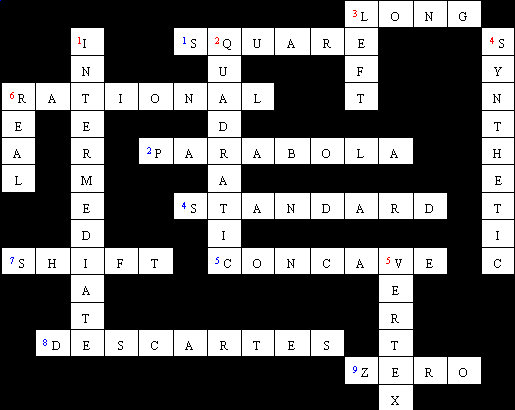| 1
. |
One of the steps involved
when writing the standard form of a polynomial is
completing the square.
|
| 2
. |
The graph of a second
degree polynomial is called a parabola.
|
| 3.
|
This is the other type of
division besides synthetic division. long |
| 4.
|
When a quadratic function
is in this form: ƒ(x)= a ( x - h )2
+ k it is said to be in standard
form. |
| 5.
|
A parabola can be concave
up or down. |
| 6.
|
The rational
zero test allows you to
find real zeros by doing p/q . |
| 7.
|
y = ƒ(x) ± c
represents a vertical shift. |
| 8.
|
Descartes Rule
of Signs was named after a mathematician who
based finding zeros on variation in signs. |
| 9.
|
A Zero
of a function ƒ is a
number x for which ƒ(x) = 0 . |
|
| 1.
|
The
Intermediate Value
Thoerem verifies the existence of real zeros of
polynomial functions. |
| 2.
|
A
parabola represents a quadratic
Function. |
| 3.
|
According
to the leading coefficient test, if the exponent
is odd and the leading coeffiecient is positive,
the the graph falls to the left
and rises to the right. |
| 4.
|
This
type of polynomial is used for divisors of the
form x - k. |
| 5.
|
The
vertex is
the highest or lowest point on a parabola. |
| 6.
|
You
can use Descartes Rule of Signs to determine the
number of positive or negative Real
zeros in a function. |
|

